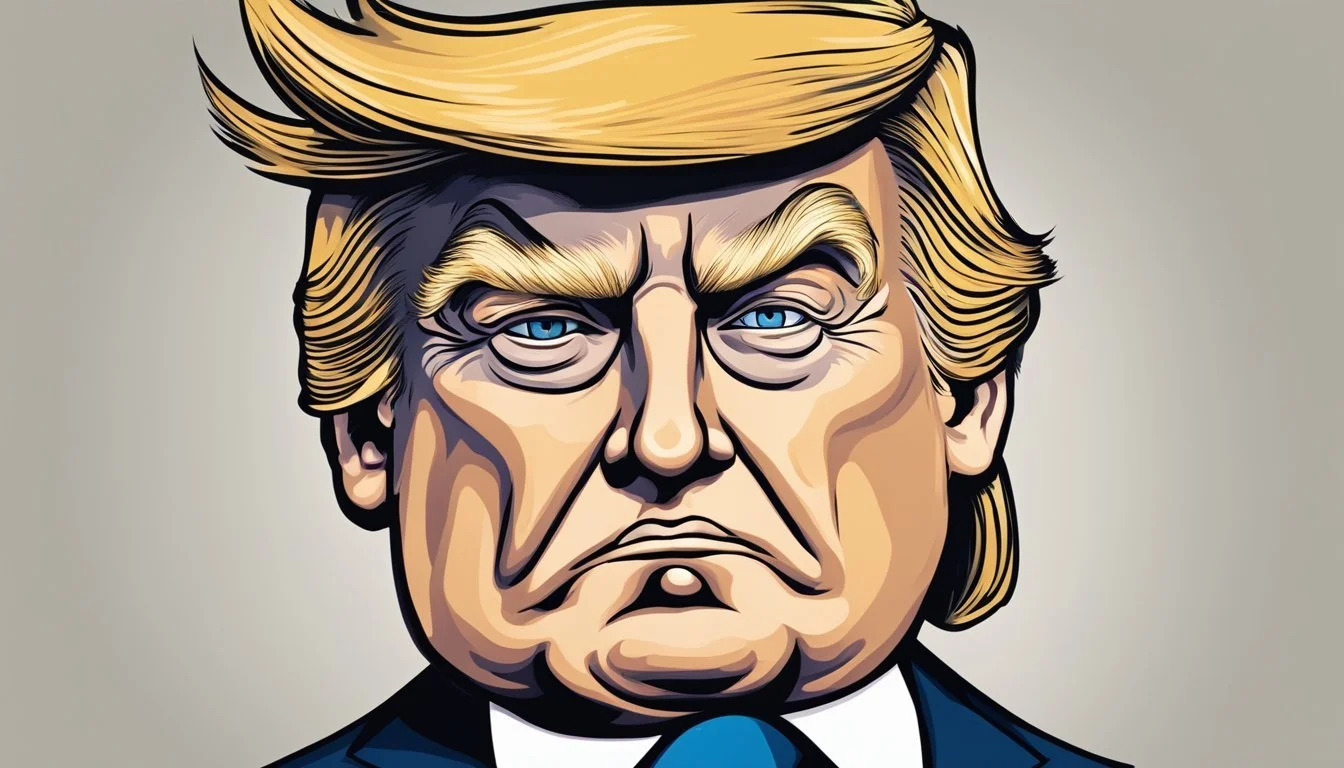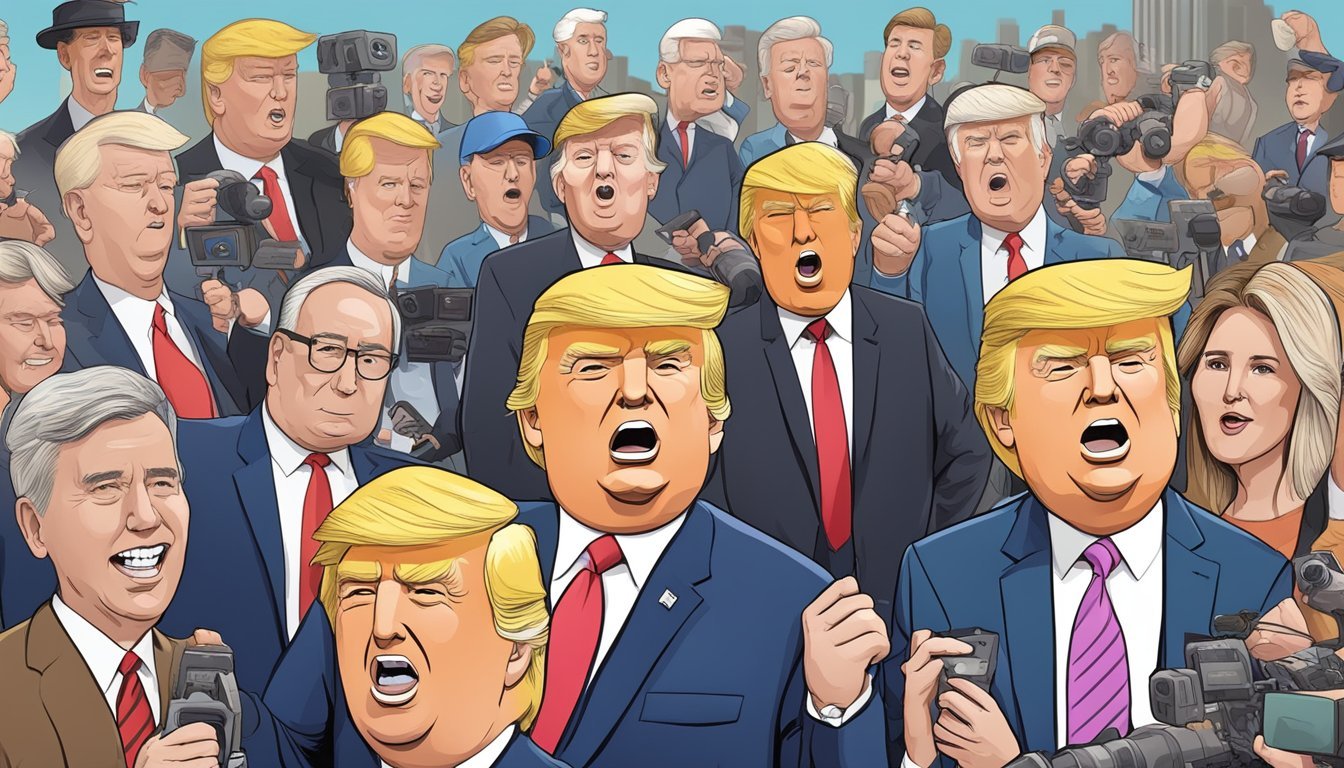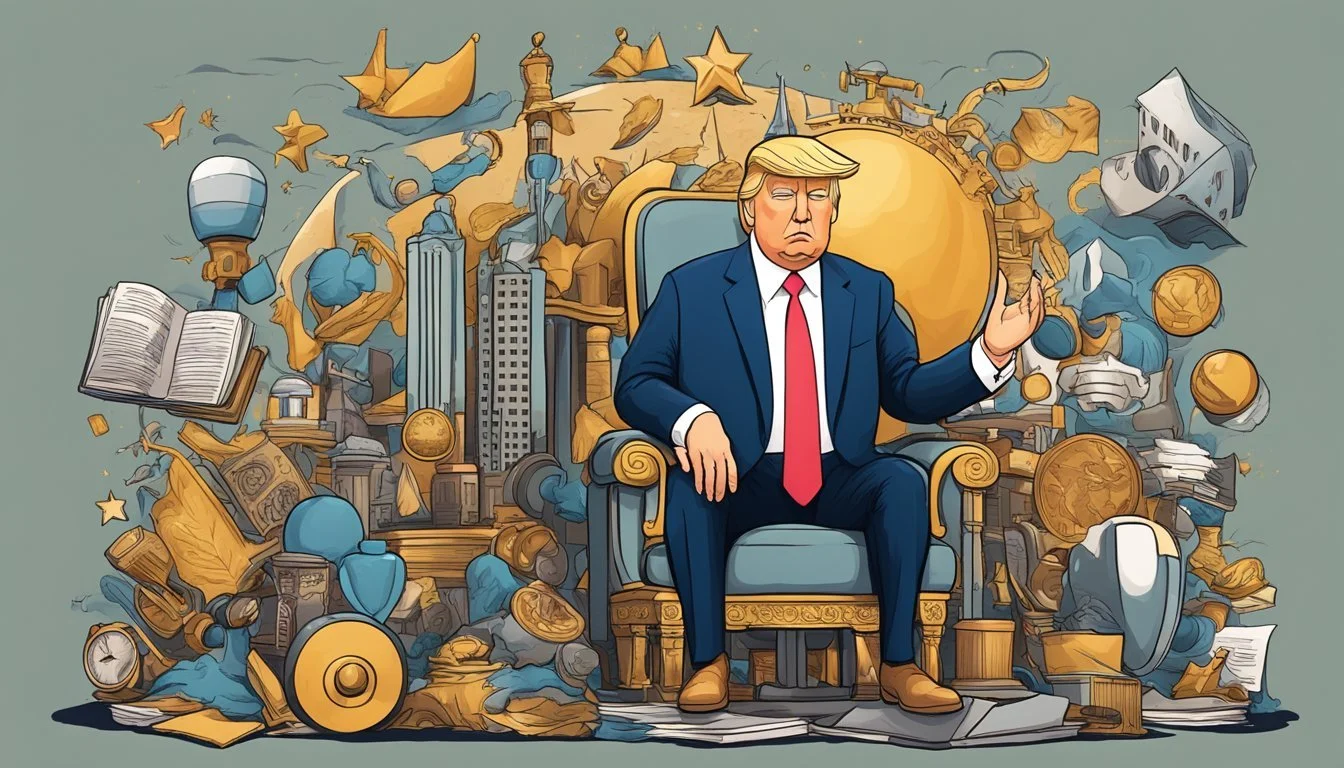Controversial Trump Animation Ignites Public Discussion
Political cartoons have long been a powerful medium for commentary and satire, and few figures have inspired as much artistic ridicule as Donald Trump. Since his entry into politics, cartoonists have enthusiastically depicted the former president's distinctive appearance, mannerisms, and controversies.
These visual commentaries offer biting critiques of Trump's policies, personality, and impact on American politics. From exaggerated portrayals of his hair and skin tone to metaphorical representations of his actions in office, cartoonists have found endless material in the Trump presidency and its aftermath.
The popularity of Trump-focused cartoons reflects the polarizing nature of his public persona. While supporters may view these depictions as unfair attacks, critics often see them as cathartic expressions of frustration or pointed political commentary. Regardless of one's stance, these cartoons have become an integral part of the political discourse surrounding Donald Trump's ongoing influence in American politics.
The Rise of Donald Trump in Political Cartoons
Donald Trump's ascent in politics provided rich material for cartoonists. His distinct appearance, controversial statements, and unconventional approach to governance inspired countless satirical depictions across media.
Early Depictions
Cartoonists initially portrayed Trump as a bombastic businessman and reality TV star. His signature hairstyle and orange-tinted skin became instantly recognizable caricature elements. Early cartoons often featured Trump's properties and ventures, like Trump Tower and his casino businesses.
As he entered politics, artists emphasized his outspoken nature and penchant for self-promotion. Many cartoons depicted Trump with an oversized mouth or megaphone, symbolizing his loud rhetoric and media dominance.
Presidential Campaign and Election
During the 2016 campaign, cartoonists ramped up their focus on Trump. His "Make America Great Again" slogan and proposed border wall became frequent visual motifs. Artists contrasted Trump with Hillary Clinton, often portraying their debates and Twitter exchanges.
Election night brought a flood of cartoons showing shocked pollsters and a triumphant Trump. Many depicted him as an unexpected wrecking ball or tornado hitting Washington D.C.
Significant Events and Policies
Trump's presidency provided a constant stream of material for cartoonists. The Muslim travel ban, attempts to repeal Obamacare, and tax cuts featured prominently. His "America First" foreign policy was often depicted through isolationist imagery.
The Russia investigation and impeachment proceedings inspired numerous cartoons. Artists frequently used Russian themes or portrayed Trump entangled in webs of lies. His Twitter habits remained a persistent subject, with many cartoons showing him furiously tweeting from the Oval Office.
Evolution of Style and Tone in Trump Cartoons
Donald Trump's prominence in political cartoons has evolved significantly over the years. Artists have employed diverse techniques to capture his persona, utilizing satire and adapting their styles to reflect changing political landscapes.
Artistic Interpretations
Cartoonists have developed distinctive visual shorthand for Trump. His iconic hairstyle and orange-tinted skin became exaggerated hallmarks in many depictions. Some artists opted for more realistic portrayals, while others leaned into caricature.
Early cartoons often focused on Trump's business persona and reality TV fame. As his political career advanced, artists incorporated more political symbols and settings into their work.
The level of detail in Trump cartoons varied widely. Some favored minimalist line drawings, while others created elaborate scenes filled with metaphorical elements and visual puns.
Use of Satire
Satire played a crucial role in Trump-themed cartoons. Artists employed irony, exaggeration, and ridicule to comment on his policies, statements, and behavior.
Some cartoonists used subtle humor, relying on viewers' knowledge of current events. Others opted for more direct, biting satire that left little room for interpretation.
As Trump's presidency progressed, the tone of many cartoons shifted. Early works often portrayed him as an unlikely or unprepared candidate. Later cartoons tackled more serious themes related to his administration's actions and impact.
Representation in International Media
Trump's global impact led to varied portrayals in international cartoons. European artists often emphasized his populist rhetoric and conflicts with traditional allies.
Middle Eastern cartoonists frequently focused on Trump's foreign policy decisions, particularly regarding Israel and Iran. His trademark hairstyle became a universal visual shorthand across cultures.
Asian political cartoons tended to highlight trade disputes and diplomatic tensions. Many incorporated local cultural references to contextualize Trump's actions for their audiences.
The Role of Cartoons in Political Commentary
Political cartoons serve as powerful tools for shaping public discourse and preserving historical moments. They offer unique perspectives on current events and political figures through visual satire and commentary.
Influence on Public Opinion
Political cartoons can sway voters' views and spark conversations. Their visual nature makes complex issues more accessible to a wide audience. A single image can convey a strong message that resonates with readers.
Cartoonists use exaggeration and symbolism to highlight key aspects of political situations. This helps viewers grasp core concepts quickly.
During the Trump presidency, cartoons played a significant role in framing public perception. They depicted Trump's policies, statements, and personality traits in ways that reinforced or challenged existing opinions.
Cartoons as Historical Records
Political cartoons capture the mood and issues of their time. They provide valuable insights into past events and attitudes for future generations.
These visual commentaries often reflect the social and political climate more vividly than written accounts. Historians use them to understand public sentiment during specific periods.
Trump-era cartoons will likely serve as important historical documents. They illustrate the divisive nature of his presidency and the major events that shaped those years.
Cartoons also reveal how different media outlets and artists interpreted the same events. This variety of perspectives enriches our understanding of historical moments.
Media and Distribution Channels
Political cartoons featuring Donald Trump circulate widely through various media channels. These satirical illustrations reach audiences through traditional print publications, digital platforms, and social networks.
Print Media
Newspapers and magazines remain important outlets for Trump-focused political cartoons. Editorial pages of major publications like The New York Times, The Washington Post, and USA Today regularly feature cartoons lampooning Trump. Weekly news magazines such as Time and The New Yorker also publish Trump cartoons. Some cartoonists create syndicated strips distributed to multiple newspapers nationwide.
Local and regional papers often run Trump cartoons from wire services or freelance artists. Political cartoon compilations in book form allow for curated collections of Trump-related artwork. These print formats provide a tangible, lasting medium for cartoon commentary on Trump's actions and policies.
Online Platforms
Digital news sites and web-based publications have become key distributors of Trump cartoons. Websites like Politico, The Hill, and The Daily Beast frequently embed political cartoons in articles about Trump. Dedicated cartoon aggregators such as Cagle Cartoons and The Cartoon Movement showcase diverse Trump-related artwork from global contributors.
Many cartoonists maintain personal websites or blogs to self-publish their Trump illustrations. Online magazines like Slate and The Atlantic feature Trump cartoons in their opinion sections. Some artists create animated political cartoons about Trump for video platforms like YouTube.
Social Media and Virality
Social media platforms play a crucial role in spreading Trump cartoons to wide audiences. Twitter is particularly popular among political cartoonists for sharing their latest Trump-focused work. Facebook groups and pages dedicated to political humor frequently post and discuss Trump cartoons.
Instagram allows artists to showcase their Trump illustrations visually. Reddit communities focused on politics or humor often upvote and discuss Trump cartoons. The viral nature of social media enables impactful Trump cartoons to reach millions quickly, sparking further commentary and debate online.
Engagement and Audience Relationship
Political cartoons featuring Donald Trump spark diverse reactions and interactions from viewers. These satirical artworks inspire debate, encourage sharing, and often lead to increased audience engagement through various channels.
Reader Responses
Trump cartoons elicit strong emotions from both supporters and critics. Many readers leave comments expressing agreement or disagreement with the cartoonist's perspective. Some share personal anecdotes related to the cartoon's topic. Others engage in heated debates, defending or attacking Trump's policies and actions.
Online forums and social media platforms see increased activity when provocative Trump cartoons are published. Readers dissect the symbolism and critique the artist's skill. Publications track metrics like time spent viewing cartoons and scroll depth to gauge reader interest.
Calls to Action
Political cartoons often include subtle or overt calls to action. Some encourage readers to vote, contact elected officials, or participate in protests. Others prompt viewers to fact-check claims or seek additional information on complex issues.
Many publications use Trump cartoons as entry points to longer articles or opinion pieces. They may include links to related content, inviting readers to explore topics in greater depth. Some cartoonists add QR codes or short URLs within their artwork, leading to petitions or donation pages.
Subscription and Sharing
Trump cartoons serve as powerful tools for audience growth and retention. Publications like The Week offer free daily emails featuring political cartoons as a teaser for their paid content. These newsletters aim to convert casual readers into subscribers.
Social media sharing of Trump cartoons extends their reach beyond traditional readership. Viral cartoons can significantly boost a publication's visibility and attract new followers. Some outlets encourage sharing by adding social media buttons or "share this cartoon" prompts alongside their content.
Publications often promote their "best features," including curated collections of Trump cartoons, to highlight the value of a subscription. By offering exclusive cartoon content, they incentivize readers to sign up for paid access or premium tiers.
Compilation and Curation
Political cartoons featuring Donald Trump are collected and organized in various ways to provide insight and commentary on his political career and impact. Editorial choices, thematic collections, and curated exhibitions shape how these cartoons are presented to the public.
Editorial Choices
Newspapers and online publications carefully select Trump cartoons that align with their editorial stance and resonate with their audience. Editors consider factors like artistic quality, humor, and relevance to current events. The Washington Post, for example, features Ann Telnaes' cartoons on Trump, which offer sharp political commentary.
Publications often compile "Best Cartoons" collections, highlighting the most impactful or popular Trump-themed artwork. These selections reflect the biggest news stories and public sentiment surrounding the former president.
Thematic Collection
Curators organize Trump cartoons into thematic groups, allowing for in-depth exploration of specific aspects of his presidency and campaigns. Common themes include:
Trump's Twitter usage
Foreign policy decisions
Impeachment proceedings
2024 presidential campaign
These collections provide a visual narrative of Trump's political journey and public perception over time. They often appear in special editions of magazines or dedicated online galleries.
Exhibitions and Books
Trump cartoons are featured in art exhibitions and published books, offering a more comprehensive look at his portrayal in political satire. Museums and galleries curate shows that contextualize these cartoons within broader political and social movements.
Books compiling Trump cartoons serve as historical records and commentary on his presidency. These publications often include analysis from political experts and cartoonists, providing additional context to the artwork.
Some notable exhibitions and books have focused on:
Trump's rise to political power
His presidency's impact on American democracy
Comparisons to other controversial political figures
These curated collections help preserve and analyze the role of political cartoons in shaping public discourse around Donald Trump.
Cultural Impact and Legacy
Donald Trump's presence in political cartoons has significantly shaped public perception and discourse. His unique persona and controversial presidency have provided rich material for cartoonists, influencing both media representation and popular culture.
Celebrity and Influence
Trump's celebrity status prior to his presidency set him apart from traditional politicians. Cartoonists capitalized on his recognizable image, often exaggerating his distinctive hair and facial expressions. This visual shorthand became instantly identifiable to audiences across the political spectrum.
His active use of social media, particularly Twitter, gave cartoonists a constant stream of material. Many cartoons incorporated tweet-like text or Twitter bird imagery to reference his online presence.
Trump's influence extended beyond politics, affecting fashion, language, and entertainment. Phrases like "fake news" and "Make America Great Again" became cultural touchstones, frequently appearing in cartoons as symbols of his administration.
Comparative Studies with Other Presidents
Trump's portrayal in cartoons differs markedly from his predecessors. While other presidents were often depicted with dignity or gravitas, Trump cartoons tend to be more exaggerated and satirical.
Left-leaning cartoonists frequently amplified Trump's image, using it as a focal point for criticism. In contrast, right-leaning cartoonists often downplayed his physical presence, focusing instead on policy issues or his opponents.
Comparisons to other controversial presidents like Richard Nixon are common, with cartoonists drawing parallels between scandals and impeachment proceedings.
Future Projections
The impact of Trump-era cartoons is likely to persist beyond his presidency. His continued political activity and potential 2024 candidacy ensure ongoing cartoon coverage.
Cartoonists may focus on Trump's legal challenges, his influence on the Republican Party, and his relationship with other political figures like Joe Biden and Kamala Harris.
The style and tone of political cartoons may evolve in response to changing public sentiment and media landscapes. Digital platforms and social media are likely to play an increasing role in cartoon distribution and consumption.







